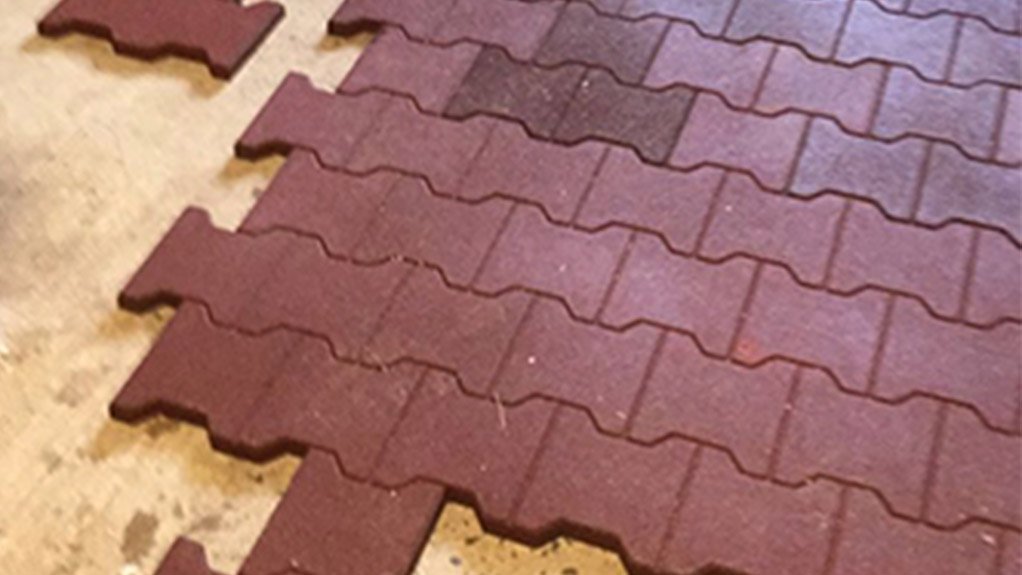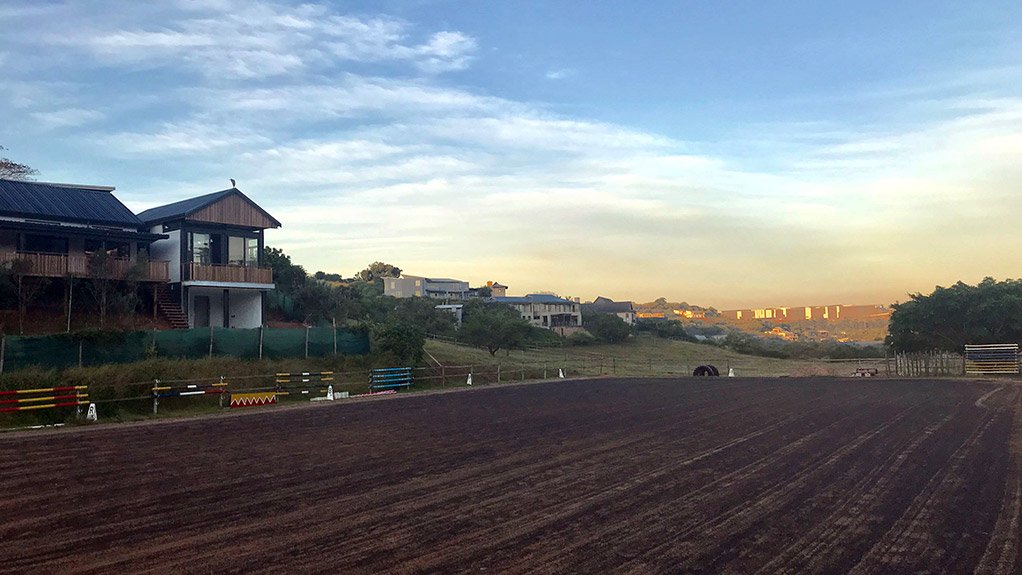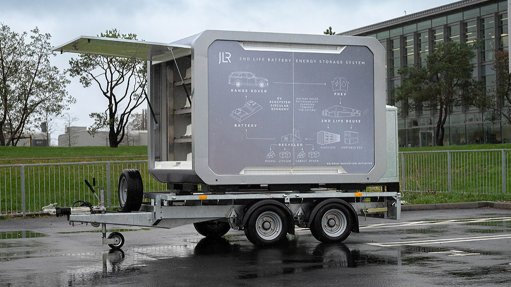Mathe Group jumps into the equestrian arena
This article has been supplied as a media statement and is not written by Creamer Media. It may be available only for a limited time on this website.
Rubber crumb produced by Mathe Group’s rubber truck tyre recycling plant in Hammarsdale, KwaZulu-Natal, has proved a highly successful addition to equestrian arenas, adding yet another innovative application to this highly successful company’s product range.
A phone call from Stephanie Ashley-Cooper, who manages Simbithi Stables, two months ago saw company head, Dr Mehran Zarrebini, begin researching the possible application of rubber crumb in equestrian arenas.
It has been used in the equestrian sector in America and Australia but not in South Africa until now.
Locally, rubber crumb, which is produced from used truck tyres delivered to Mathe Group’s Hammarsdale plant, has been used to manufacture rubber flooring and paving and acoustic underlays for carpets as well as for foundations for sports fields utilising artificial grass.
Zarrebini uncovered a study done by the equine research team at the Animal Health Trust (AHT) in Newmarket that showed that the best types of surfaces to prevent injury to horses are sand-rubber combinations or wax-coated arena surfaces. According to this and other studies, a sand and PVC mix, woodchips, and grass can cause severe injuries in sport horses. A sand and rubber mix, on the other hand, provided the best cushioning and prevented hoof slippage, significantly reducing potential injuries to limbs.
Ashley-Cooper contacted Mathe Group looking for a softer surface for the arena that is used by 16 horses stabled on the Simbithi Eco Estate near Ballito on the KwaZulu-Natal East Coast. While some are used for leisure riding by residents, many compete at a high level when it comes to both dressage and show jumping.
She explained that, just like human athletes, it is becoming increasingly important for equestrian athletes to work out on the best surfaces to achieve peak performance. While hockey and soccer players have access to astro turf facilities, horses needed something more suitable than conventional arenas in South Africa which comprise a clinker base with river sand on top.
In addition to compromising performance, this puts the horses at risk of severe injuries to their lower limbs and tendons, she points out.
She says that a number of different substances – including coconut husks and fibre – have been used to provide better cushioning and to prevent hoof slippage. However, these solutions are often extremely expensive. She was looking for a more affordable solution that did not require further investment in equipment needed to rake the surface of the arena each morning.
Zarrebini sent samples of different sizes of rubber crumb. Ultimately, the first order of five tons of 2 to 7mm rubber crumb was delivered in April. A second five-ton order followed shortly afterwards.
The arena measures 30m by 60m and the surface comprises one quarter rubber crumb to three quarters sand.
Ashley-Cooper says that the rubber crumb, which was mixed with the sand in the arena, has performed better and better over time as it has been repeatedly recombined in with the existing substrate and levelled and raked each day.
“The surface gets better and better as we use it. The horses who are working there seem to float over the surface as opposed to sinking into the sand,” she explains, adding that it has created a lighter surface that has a certain “bounciness.”
However, one of the chief advantages is the value and longevity that comes with the use of rubber crumb which does not degenerate with use, the weather and repeated watering as products like coconut husk do, needing to be frequently replaced.
In addition to using rubber outside, Zarrebini and Ashley-Cooper have also discovered another use for products made from recycled rubber in equestrian facilities.
Samples of rubber vulcanised mats produced at Mathe Group’s sister company, Van Dyck Floors in Mobeni, were also sent to Simbithi Stables. These were placed over the concrete floors of the stables.
Ashley-Cooper explains that horses usually sleep on a bed of wood chips placed on the concrete floors. The rubber mats are not only far warmer and more comfortable for the horses but also prevent the sores that often result from horses getting up after lying down to sleep on hard concrete floors.
An added bonus is that the use of rubber mats over the concrete floors means that less wood chip bedding is needed.
She says less wear and tear on the horses’ hooves and legs in the stable environment could see her ultimately invest further in rubberising walk ways as funds become available.
Zarrebini says that finding more and more applications for recycled rubber tyres is not only a commercial but also an ecological success story. Up until a few years ago, tons of used tyres were building up into a potential environmental disaster in South Africa as there seemed to be very few uses for the products that would result from recycling them.
That has now changed, and Mathe Group expects to reduce approximately 200 000 used truck tyres into rubber crumb and other useful products during 2018 alone.
Comments
Press Office
Announcements
What's On
Subscribe to improve your user experience...
Option 1 (equivalent of R125 a month):
Receive a weekly copy of Creamer Media's Engineering News & Mining Weekly magazine
(print copy for those in South Africa and e-magazine for those outside of South Africa)
Receive daily email newsletters
Access to full search results
Access archive of magazine back copies
Access to Projects in Progress
Access to ONE Research Report of your choice in PDF format
Option 2 (equivalent of R375 a month):
All benefits from Option 1
PLUS
Access to Creamer Media's Research Channel Africa for ALL Research Reports, in PDF format, on various industrial and mining sectors
including Electricity; Water; Energy Transition; Hydrogen; Roads, Rail and Ports; Coal; Gold; Platinum; Battery Metals; etc.
Already a subscriber?
Forgotten your password?
Receive weekly copy of Creamer Media's Engineering News & Mining Weekly magazine (print copy for those in South Africa and e-magazine for those outside of South Africa)
➕
Recieve daily email newsletters
➕
Access to full search results
➕
Access archive of magazine back copies
➕
Access to Projects in Progress
➕
Access to ONE Research Report of your choice in PDF format
RESEARCH CHANNEL AFRICA
R4500 (equivalent of R375 a month)
SUBSCRIBEAll benefits from Option 1
➕
Access to Creamer Media's Research Channel Africa for ALL Research Reports on various industrial and mining sectors, in PDF format, including on:
Electricity
➕
Water
➕
Energy Transition
➕
Hydrogen
➕
Roads, Rail and Ports
➕
Coal
➕
Gold
➕
Platinum
➕
Battery Metals
➕
etc.
Receive all benefits from Option 1 or Option 2 delivered to numerous people at your company
➕
Multiple User names and Passwords for simultaneous log-ins
➕
Intranet integration access to all in your organisation























